
Solifugae is an order of animals in the class Arachnida known variously as camel spiders, wind scorpions, sun spiders, or solifuges. The order includes more than 1,000 described species in about 147 genera. Despite the common names, they are neither true scorpions nor true spiders. Most species of Solifugae live in dry climates and feed opportunistically on ground-dwelling arthropods and other small animals. The largest species grow to a length of 12–15 cm (5–6 in), including legs. A number of urban legends exaggerate the size and speed of the Solifugae, and their potential danger to humans, which is negligible.
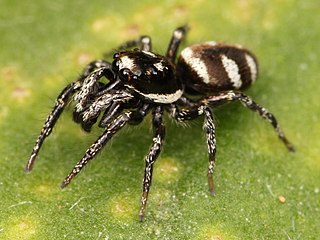
The zebra spider is a common jumping spider of the Northern Hemisphere. Their common name refers to their vivid black-and-white colouration, whilst their scientific name derives from Salticus from the Latin for “jump”, and the Greek scenicus, translating to “theatrical” or “of a decorative place,” in reference to the flashy, zebra-like coloration of the species.
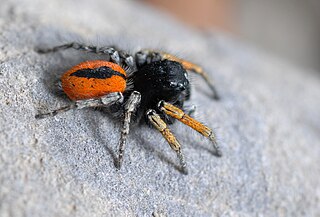
Philaeus chrysops is a species of jumping spider (Salticidae).
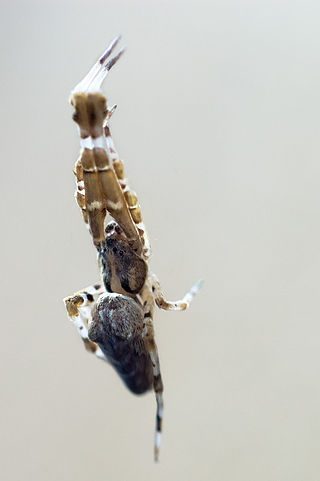
Uloborus walckenaerius, also known as the feather-legged spider, is a cribellate spider in the family Uloboridae. Like all spiders in this family, they do not have venom glands and immobilize their prey with over 140 metres of thread. They are named in honor of Charles Athanase Walckenaer.

The anatomy of spiders includes many characteristics shared with other arachnids. These characteristics include bodies divided into two tagmata, eight jointed legs, no wings or antennae, the presence of chelicerae and pedipalps, simple eyes, and an exoskeleton, which is periodically shed.
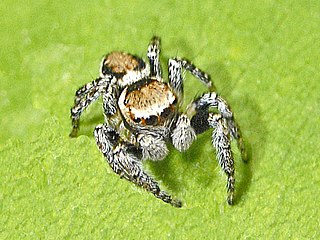
Evarcha falcata is a species of 'jumping spiders' belonging to the family Salticidae.

Zygoballus sexpunctatus is a species of jumping spider which occurs in the southeastern United States where it can be found in a variety of grassy habitats. Adult spiders measure between 3 and 4.5 mm in length. The cephalothorax and abdomen are bronze to black in color, with reddish brown or yellowish legs. The male has distinctive enlarged chelicerae and front femora. Like many jumping spiders, Z. sexpunctatus males exhibit ritualized courtship and agonistic behavior.
This glossary describes the terms used in formal descriptions of spiders; where applicable these terms are used in describing other arachnids.

Carrhotus xanthogramma is a species of jumping spider belonging to the family Salticidae.
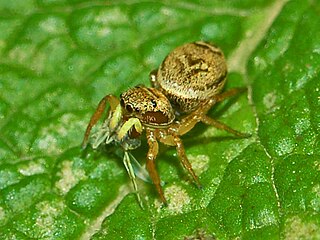
Heliophanus tribulosus is a species of 'jumping spiders' belonging to the family Salticidae.
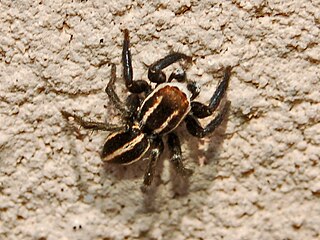
Phlegra bresnieri is a species of jumping spiders. Its specific name bresnieri honors the 19th-century French Arabist Louis-Jacques Bresnier.

Araneus mitificus, commonly known as the kidney garden spider or pale orb weaver is a species of orb-weaver spider found in South, East, and Southeast Asia.

Attulus inexpectus is a species of spider from family Salticidae, found in from Europe to central Asia. It was previously misidentified as Attulus rupicola.

Progradungula otwayensis, commonly known as the odd-clawed spider, is a species of cribellate spider endemic to the Great Otway National Park of Victoria, Australia. It is one of only two species in the gradungulid genus Progradungula.

Hyptiotes paradoxus, also known as the triangle spider, is a cribellate orbweaver in the family Uloboridae.

Heliophanus cupreus, the copper sun jumper, is a species of jumping spider belonging to the family Salticidae.
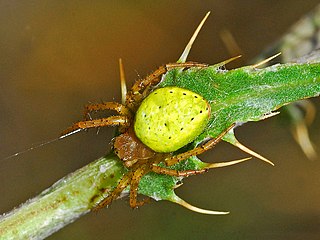
Araniella opisthographa is a species of orb weaver in the spider family Araneidae.

Orestes bachmaensis is a Phasmatodea species native to central Vietnam.

Orestes subcylindricus is a species of stick insects native to Vietnam.
Nesticella quelpartensis, sometimes referred to as the Jeju cave baby spider, is a species of spider found only in South Korea. Its sole habitat is the lava caves of Jeju Island.


















